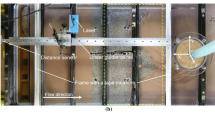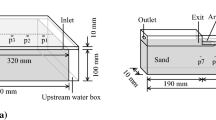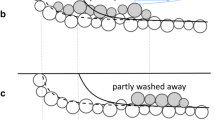Abstract
Backward erosion piping (BEP) is a failure mechanism that can affect the safety of water-retaining structures. It can occur when a local anomaly on the downstream side of an embankment causes a concentration of seepage flow at that location. Shallow pipes may then form, progressing in the upstream direction and leading to a collapse of the water-retaining structure. A novel and economically appealing measure against BEP is the coarse sand barrier (CSB), which is now being developed in a multiscale experimental programme in the Netherlands. The method involves placing a trench filled with coarse sand below the blanket layer on the downstream side of the embankment. The CSB prevents the upstream progression of the pipe and significantly enhances resistance to BEP. This paper presents medium-scale laboratory tests involving a range of sands, barrier depths and relative densities. The piping process and the observations of pipe progression in the presence of a CSB are presented, followed by a conceptual model. The presence of a CSB changed the erosion pattern. It resulted in pipe formation perpendicular to the flow direction over the entire width of the barrier before the barrier was damaged. The findings also demonstrate the effect of material properties on pipe initiation, progression and pipe depth. Measurements of the pipe depth are presented and analysed, revealing the significance of pipe depth for understanding the piping process. This analysis shows considerable erosion in the downstream background sand and demonstrates that erosion profiles and measured pipe depths are significantly larger than in BEP tests without a CSB.









Similar content being viewed by others
Abbreviations
- C u :
-
Uniformity coefficient, the ratio d60/d10
- h cf :
-
Effective head drop at the critical point in time for failure
- RD:
-
Relative density based on void ratio (emax − e)/(emax − emin)
- n :
-
Porosity of soil
- k :
-
Hydraulic conductivity
- l :
-
Length of the set-up
- w :
-
Width of the set-up
- h :
-
Height of the set-up
- d x :
-
Grain diameter at which x% of sample (by weight) is finer
References
Akrami S, Bezuijen A, Rosenbrand E et al (2018) Investigating the formation of the filter cake in column experiments, for combinations of filter and fine sand in a coarse sand barrier. In: Internal erosion in earthdams, dikes and levees proceedings of EWG-IE 26th annual meeting. LNCE 17. Springer, Cham, pp 211–220
Akrami S, Bezuijen A, Van Beek VM et al (2019) Analysis of pipe progression during backward erosion piping in the presence of a coarse sand barrier. In: Internal erosion in earthdams, dikes and levees proceedings of EWG-IE 27th annual meeting. University of British Columbia, Vancouver, pp 30–31
Bezuijen A, Rosenbrand E, Van Beek VM, Vandenboer K (2018) Experiments for a coarse sand barrier as a measure against backward erosion piping. In: Proceedings of 9th international conference on physical modelling in geotechnics. CRC Press Taylor & Francis Group, London, pp 1037–1042
Förster U, Koelewijn AR, Rosenbrand E et al (2019) A coarse sand barrier as an alternative preventive measure against backward erosion piping. In: Proceedings of the 17th European conference on soil mechanics and geotechnical engineering. CRC Press Taylor & Francis Group, Reykjavik, Iceland
Gu DM, Huang D, Liu HL et al (2019) A DEM-based approach for modeling the evolution process of seepage-induced erosion in clayey sand. Acta Geotech 14(5):1629–1641
Hanses U (1985) Zur Mechanik der Entwicklung von Erosionskanälen in geschichtetem Untergrund unter Stauanlagen. Dissertation, Grundbauinstitut der Technischen Universität Berlin, Berlin, Germany (in German)
Ji Z, Leu MC (1989) Design of optical triangulation devices. Opt Laser Technol 21(5):339–341
Koelewijn A, Van Beek VM, Förster U et al (2018) Employing process knowledge of backward erosion piping to devise effective countermeasures. In: Proceedings of the 26th international congress on large dams. CRC Press Taylor & Francis Group, Vienna, Austria
Miesel D (1978) Rückschreitende Erosion unter bindiger Deckschicht. In: Proceedings of the Baugrundtagung. Springer, Berlin, pp 599–626
Müller-Kirchenbauer H, Hanses U (1980) Zum zeitlichen Verlauf der Rückschreitenden Erosion in geschichtetem Untergrund unter Dämmen und Stauanlagen. In: Proceedings of Talsperren symposium, Munich, Germany (in German)
Navin M (2016) Kaskaskia Island and bois brule levee breaches during the 1993 Mississippi river flood. In: Proceedings of USSD international symposium on the mechanics of internal erosion for dams and levees. Salt Lake City, Utah, USA
Negrinelli G, Van Beek VM, Ranzi R (2016) Experimental and numerical investigation of backward erosion piping in heterogeneous sands. In: Proceedings of the 8th international conference on scour and erosion. CRC Press Taylor & Francis Group, Oxford, UK, pp 473–482
ODS Grey-Line Distance Sensor. www.danish-sensor-engineering.com. https://www.danish-sensor-engineering.com/wp-content/uploads/2020/03/ODS-Grey-Line-Data-Sheet.pdf. Accessed 26 May 2020
Robbins BA, Van Beek VM, López-Soto JF, Montalvo-Bartolomei AM, Murphy J (2018) A novel laboratory test for backward erosion piping. Int J Phys Modell Geotech 18(5):266–279
Rosenbrand E, Van Beek VM, Koelewijn AR et al (2018) Scale effects in coarse sand barrier experiments. In: Internal erosion in earthdams, dikes and levees proceedings of EWG-IE 26th annual meeting. Springer, Milan, Italy, pp 301–312
Rosenbrand E, Van Beek VM, Förster U et al (2019) Large-scale test of a coarse sand barrier as a measure against backward erosion piping. In: Internal erosion in earthdams, dikes and levees proceedings of EWG-IE 27th annual meeting. University of British Columbia, Vancouver, Canada, pp 23–25
Schmertmann JH (2000) The non-filter factor of safety against piping through sands. In: Silva F, Kavazanjian E (eds) Judgment and innovation. American Society of Civil Engineers, Reston, VA, USA, Geotechnical Special Publication no. 111, pp 65–132
Sellmejer JB (1988) On the mechanism of piping under impervious structures. PhD Thesis, Delft University of Technology, Delft, The Netherlands
Van Beek VM (2015) Backward erosion piping, initiation and progression. PhD thesis, Delft University of Technology, Delft, The Netherlands
Van Beek VM, Knoeff H, Sellmeijer H (2011) Observations on the process of backward erosion piping in small-, medium- and full- scale experiments. Eur J Environ Civil Eng 15(8):1115–1137
Van Beek VM, van Essen HM, Vandenboer K, Bezuijen A (2015) Developments in modelling of backward erosion piping. Géotechnique 65(9):740–754
Van Rhee C, Bezuijen A (1992) Influence of seepage on stability of sandy slope. J Geotech Eng 118(8):1236–1240
Vandenboer K, Van Beek VM, Bezuijen A (2019) Analysis of the pipe depth development in small-scale backward erosion piping experiments. Acta Geotech 14(2):477–486
Vrijling JK, Kok M, Calle EOF et al (2010) Piping: realiteit of rekenfout?. Report Expertise Netwerk Waterveiligheid, Rijkswaterstaat, The Netherlands (in Dutch). https://www.enwinfo.nl/images/pdf/Piping-Realiteit-of-Rekenfout-(72dpi).pdf
Xiao Y, Cao H, Luo G (2019) Experimental investigation of the backward erosion mechanism near the pipe tip. Acta Geotech 14(3):767–781
Yao Q, Xie J, Sun DJ, Zhao J (2009) Data collection of dike breach cases of China. Sino-Dutch cooperation project report. Institute of Water Resources and Hydropower Research, Beijing, China
Rosenbrand E, Van Beek VM, Bezuijen A et al (to be published) Multi-scale experiments for a coarse sand barrier against backward erosion piping. To be published in Géotechnique
Acknowledgements
The authors wish to thank the Dutch Rivierenland water authority for their support, as well as all the people who helped with these tests.
Author information
Authors and Affiliations
Corresponding author
Additional information
Publisher's Note
Springer Nature remains neutral with regard to jurisdictional claims in published maps and institutional affiliations.
Rights and permissions
About this article
Cite this article
Akrami, S., Bezuijen, A., van Beek, V. et al. Analysis of development and depth of backward erosion pipes in the presence of a coarse sand barrier. Acta Geotech. 16, 381–397 (2021). https://doi.org/10.1007/s11440-020-01053-0
Received:
Accepted:
Published:
Issue Date:
DOI: https://doi.org/10.1007/s11440-020-01053-0




